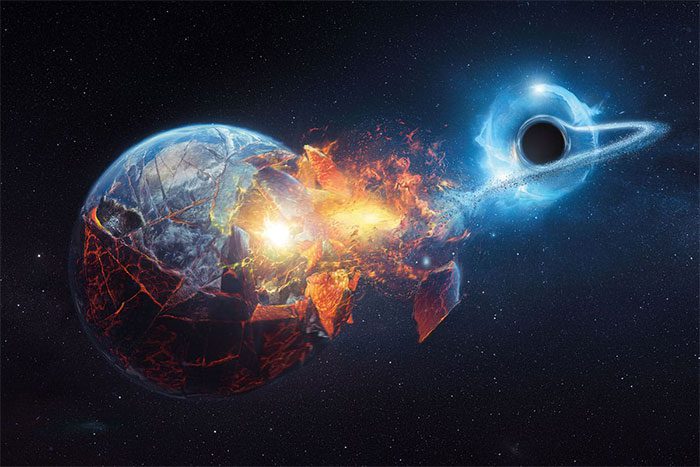A mysterious entity from the dawn of the universe has passed through our vicinity at least once every decade.
A new study from the Massachusetts Institute of Technology, the Santa Cruz Institute for Particle Physics, and the University of California, Santa Cruz (USA) suggests that primordial black holes (PBHs), invisible objects from the cosmic dawn, may have caused many planets and moons around us to wobble.

Graphic depicting “an object from the first second of the universe” approaching an Earth-like planet. However, the reality might be more benign – (Image: PHYSIC WORLD).
PBHs are a form of hypothetical object that has been mentioned in cosmology.
These extreme gravitational regions may have formed in the seconds immediately following the Big Bang, due to the collapse of hot, dense regions of space.
Depending on when they were born in this first second, PBHs can have masses ranging from 1/100,000 the mass of a paper clip to 100,000 times that of the Sun.
However, most scientists believe that the majority of PBHs have masses somewhere between those of the asteroids Juno and Eros.
More importantly, this ancient, mysterious entity is primarily made of dark matter, making it very difficult to capture.
According to the new study, although no one has obtained direct evidence of PBHs, they have revealed their presence by causing nearby planets and moons to wobble at least once every decade.
If such an object were to pass by Earth, it would not destroy our world. However, it could cause wobbling and instability as it flies by.
In the worst-case scenario, a PBH could be strong enough and close enough on its path to sweep a planet along with it. This might not be enough to completely eject that planet, but it would be sufficient to alter its distance from its star.
For a habitable planet like Earth, this would be very bad news, as the change in distance would undoubtedly lead to significant environmental and climatic changes.
Fortunately, according to scientists’ calculations, the probability of being “swept away” is low. PBHs typically only cause minor perturbations to the planets they influence.
Using data on the positions of certain planets and moons from NASA’s JPL Horizon database, researchers simulated the impact of PBHs on the Solar System.
They found that if a PBH with the mass of an asteroid passed through a region 2 astronomical units away from the Sun (twice the distance from the Sun to Earth), the orbits of the planets and moons would wobble by 1 inch (2.54 cm) to several feet (1 foot = 30.48 cm) over the years.
Thus, scientists hope that devices like those NASA has used to measure distances with centimeter-level precision from Mars to Earth will provide important clues to identify PBHs.


















































